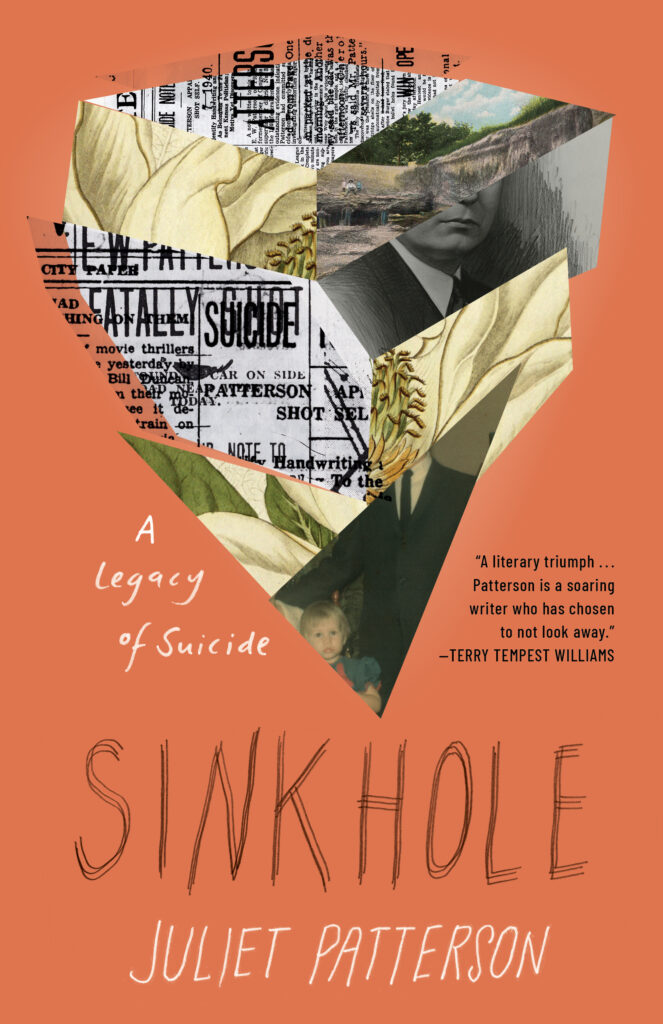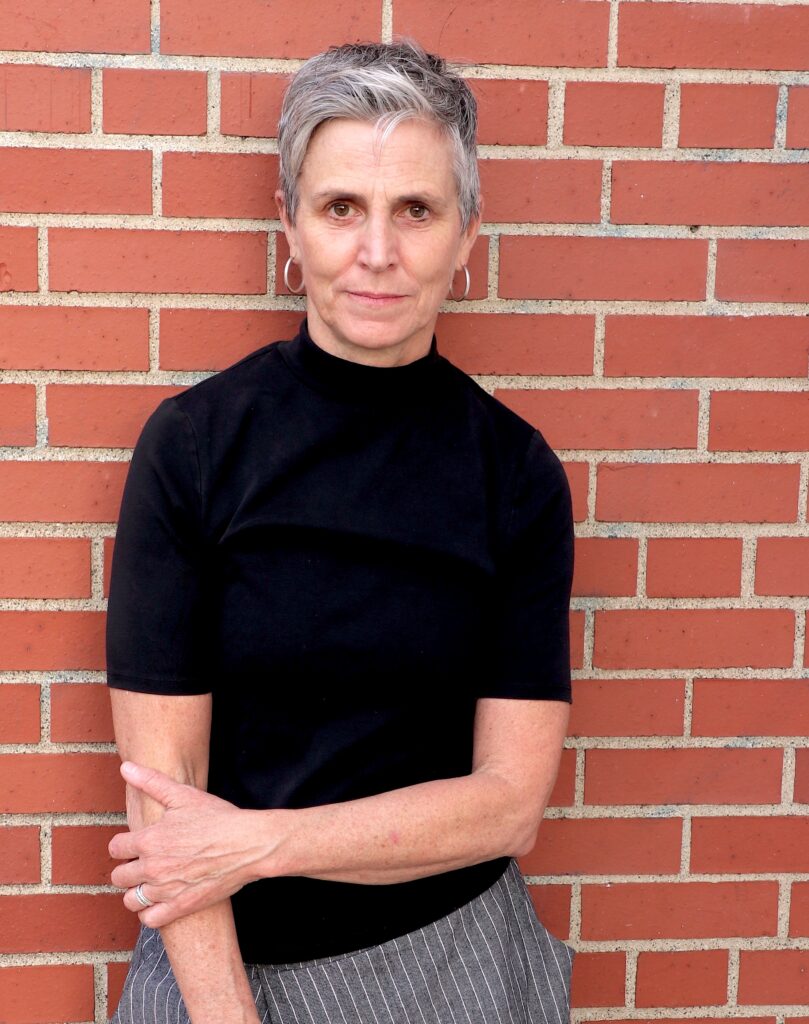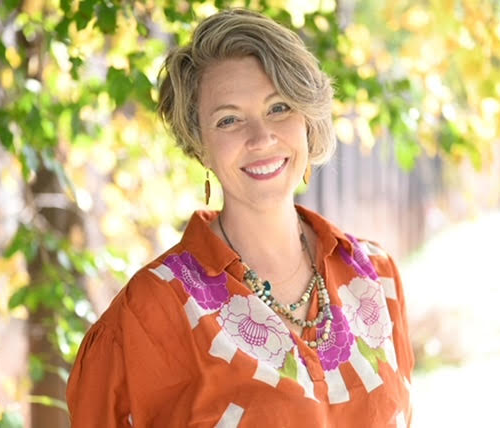Interview by Leslie Lindsay
 A still life, according to Merriam-Webster, is “a picture consisting predominantly of inanimate objects,” but in Juliet Patterson’s elegantly fractured reckoning with the legacy of suicide, it is anything but still.
A still life, according to Merriam-Webster, is “a picture consisting predominantly of inanimate objects,” but in Juliet Patterson’s elegantly fractured reckoning with the legacy of suicide, it is anything but still.
In three graceful movements, Patterson traverses the detritus of loss in a “a vacant prairie” following the suicide of her father, but also, a crushing car accident of her own. What’s more, she discovers a disturbing familial pattern: both her maternal and paternal grandfather also died by suicide.
Why had her family lost so many men, so many fathers, and what lay beneath the silence that had taken hold?
Sinkhole: A Legacy of Suicide (Milkweed Edition; September 2022) is Patterson’s answer. It’s part-investigation, part- memoir, part-ecological, and pure poetry.
In the winter of her father’s death, Patterson struggles to make sense of the loss—she sifts through his few belongings seeking signs and symbols for meaning. As the spring thaw arrives, she and her mother depart Minnesota for her father’s burial in Kansas, a town besieged by abandoned mines and sinkholes. Over the course of summers and autumns, and winters again, Patterson conducts interviews and investigations. She holds inanimate objects, and then life itself. In the end, she holds the memory of her father; the concepts of ‘good-bye,’ and perhaps, most importantly: how to break the cycle.
As a writer and artist—and also a daughter of a mother who died by suicide—I am continually taunted by the intricacies of time, memory, and the play of objects on society. Sinkhole: A Legacy of Suicide is a lyrical body of work fused by the examination of hundreds of documents, newspaper articles, photographs, and other ephemera. It may be so bold as to say each of these items—and the land—once held a tactile energy. It was anything but still.
Please join me in conversation with Juliet Patterson.

Image Credit: Ayanna Muata
Leslie Lindsay: Sinkhole begins in December, at the end of the year, in snowy Minnesota. “The moon is almost in the last quarter. The sky is clear but pitch black,” you write. This season is quite evocative of the mood, the dismal grief you are sure to experience. I’m curious if that was your intention as you considered the structure for this narrative?
Juliet Patterson: The writing that became Sinkhole was composed over many years. I wrote through grief, to understand grief. And I wrote in response to the many questions I held in the aftermath of my father’s death. It wasn’t my plan to write a memoir. It took several years to understand my commitment to the project and to submit to the power of the sentence, to the power of prose.
As a poet, I’d previously written in the mode of the lyric and fragment. I understood very little about narrative: finding a structure for the book was one of the hardest problems to solve. There were many false starts. And a lot of revision. I gave a lot of attention to the opening of the book in draft after draft after draft. And yes, my intent was to not only set the mood but to place the reader squarely in the facts of my father’s death. He died in a cold, dark season. That part of the story writes itself.
“I wrote through grief, to understand grief” — Juliet Patterson
LL: While this is a partly a story of trying to understand suicide, it is also an examination of grief, self-reflection, and investigation. It’s elegantly balanced on these three legs, grounded in geographical and historical research, which I found fascinating. Can you talk a little about your research, how you pieced everything together?
JP: I am by nature curious and do a lot of research and reading as a person and a writer, so research was a part of the process from the start. A few days after my father’s death, for example, I searched for information about the bridge where he died and took notes on my laptop to detail its history. At the same time, I began keeping a journal and writing about my grief; these two modes of writing became a practice that I sustained for several years.
The research often offered me a break from the distressing and emotional work of unpacking my personal experience–so it’s something I became pretty invested in early on in the writing process. It also allowed me to stray away from the demands of personal narrative, which I found to be extraordinarily challenging. It took a lot of practice to find my voice as a prose writer. But, piecing it all together was an even greater challenge.
I am so fortunate to have worked with Joey McGarvey, a brilliant editor, who really helped me with this aspect of the book. While I’d had some historical and geographical material in the early draft, Joey really pushed me to expand on these threads and then infused me with the confidence to find a way to stitch it all together through developmental revisions.
It was a messy and sometimes stressful process and it was one that I couldn’t have done alone. I’ve often heard writers talk about the importance of a good editor and now I understand. The balance of the book you describe was made possible only by Joey’s unwavering editorial eye.
LL: And the cover! It’s a delightful dark blend of scattered pieces from your investigations that sort of wend their way into the shape of a heart. I saw it as an analog collage, and that brought forth a mysterious—yet anchoring—artistic vision. I’m curious how that all came together?
JP: Mary Austin Speaker came up with the design for the cover. She’s one of the most talented book designers in the publishing industry and I’m so grateful for her work. Your observation about the use of analog materials is important: this was the one and only suggestion I made to Mary when we discussed ideas for the cover.
I also appreciate your use of the word mysterious here. I think that’s right. There’s something to unpack in the image, something to discover. I wrote about this in more detail in an essay for Milkweed’s blog.
LL: I found it fascinating how you juxtapose a landscape in ruins, [the coal mining community of 1870’s through 1890s Crawford County, Kansas where your family once lived] with that of the brittle expanse of your family’s mental health history. “At first[…], this region doesn’t look like […]a landscape of ruins. But the symptoms of erosion rest just below the surface. The text of a catastrophic history is hidden beneath the earth, as if the land wants to be alone with its grief.”
Land plays a large role in the narrative. Can you expand on that, please?
JP: A large part of my grieving process involved traveling to Kansas to the small town of Pittsburg, where three generations of my family lived. It was a place I hadn’t spent much time in as a child, but that I somehow understand as my ancestral home. Being there allowed me respite from my life back in Minnesota.
I could see and feel myself differently in Pittsburg, which in turn influenced the way I saw its surrounding landscape. In grief, my senses were also heightened (if not distorted) and my relationship to the land and natural world magnified. It’s difficult to describe, but I think I had an elevated sensitivity to the land, which some of the writing I did reveals.
And then on one of my visits, I unexpectedly encountered an enormous sinkhole across the street from my grandmother’s house. I had never seen a sinkhole before and it was pretty terrifying; the image really burned in my mind. I couldn’t think of it as anything but a metaphor, so the connections I made were really driven by voicing that encounter, a moment from which much of the book revolves.
LL: It begs the question then: how can we walk on solid ground if our family history is besieged with sinkholes? Isn’t the fear pervasive? Might we misstep and become sucked under?
JP: These are the questions I live with: my way of reckoning with fear has been (to paraphrase Rilke) to live with these questions deeply. The recognition that the ancestral ground under my feet might not be stable is unsettling–even frightening. But, also liberating in its truth. We can’t escape our painful histories, nor perhaps even repair them to a significant degree. But, we also can’t run from the threat (as you say) of being sucked under.
This is true personally as well as culturally. America, is in many ways, is a harmful place to live because of a failure to acknowledge its violent past. Looking into ancestral history might be one way of recognizing this truth more deeply.
Maybe the goal isn’t to find solid ground, but instead to see it for what it really is.
LL: Which leads me to ask about epigenetics, the idea that trauma is ‘carried down’ to subsequent generations. It’s impossible to know for sure, but what might we do to circumvent the same fate?
JP: I’m so interested in the subject of epigenetics and have done a lot of reading on the subject. I’m a believer, but as your question suggests–the science of intergenerational trauma is still pretty hard to scientifically prove.
I had hoped this discussion would be a bigger part of Sinkhole, but I really struggled with integrating this research into the narrative. So, in the end, a lot of this material was cut.
We do hold trauma in our bodies and I do think we are “fated” to repeat those traumas if we’re unable to recognize, understand or heal that trauma. Resmaa Menakam writes about this in the context of racialized trauma in his wonderful book, My Grandmother’s Hands. He argues that racialized destruction will continue unless Americans can learn to heal the generational pain of white supremacy.
Donald Antrim writes about this also in his book One Friday in April: A Story of Suicide and Survival, by naming suicide a “social disease.” I didn’t read Antrim’s book until I was finished with Sinkhole, but this idea really resonates with me and is a central belief I hold about suicide.
In my own family, I see the ways white supremacy played into what journalist Amy Westervelt refers to as “America’s obsession with personal responsibility,” in a beautiful essay she published online. Regarding her father, she writes: “He had bought into the American dream so hard, the idea that if you just worked hard enough and you were talented, things would work out for you. And if they didn’t, well you probably hadn’t worked hard enough or maybe you just weren’t that smart or talented.” The meritocracy Westerveldt describes is–just as the economist (Michael Young) who invented the term predicted–a social calamity.
But, getting back to your question of fate. Is fate just another idea sprung from this “cult of personal responsibility”? I’m suspicious of how the idea of fate might be wielded, particularly when it comes to the idea of inheritance. I’ll paraphrase Benedict Carey here (and I quote directly from him in the book) who says that the idea of genetic ancestral pain has strong “emotional appeal.” Again, this isn’t to dismiss the possibility. As I’ve already mentioned, I do believe we carry emotional trauma along generations. But, I guess for me, the bigger question is: how can we attend to the collective traumas of America’s history? And what needs to change to heal collective harms?
LL: I wanted to end with a few sobering facts uncovered in Sinkhole: A Legacy of Suicide. The CDC reports suicide takes the lives of more than 47,500 Americans each year (that’s 130 suicides a day), men die by suicide three and a half times more often than women. For every suicide, there’s an estimated 29 attempts.
Contrary to popular belief, the holiday season is actually a lower time incidence (the rates are higher in the spring). Not everyone who dies by suicide leaves a note (and I found your research on this fascinating). I realize there is no cure for suicide, only awareness, and prevention. Can you illuminate some other facts, and also—what can we do to help?
JP: I recently finished reading Deaths of Despair and the Future of Capitalism, by economists Anne Case and Angus Deaton: that book offers a broader context for these statistics, emphasizing some of the ideas I was just discussing. Their book begins with the surprising revelation that all deaths (not just suicides) in America are increasing by large numbers. This is really unusual, as death rates (outside of war or pandemics) have been falling for decades and it’s something Case and Deaton wanted to understand.
Their research reveals that an average of 70,000 Americans die annually from what they call “deaths of despair” (death by suicide, overdose, and alcohol-related illnesses). There are long-term economic and social reasons for this. Case and Deaton explain it as a slow failure of American capitalism and link these deaths to a weakening position of labor, to the power of corporations, and to a prohibitively expensive (market-driven) healthcare system.
This is another book I read after I had completed Sinkhole and while my search to answer questions about suicide was very personal, I was also deeply interested in understanding the social factors surrounding suicide, so this book really helped me to continue my thinking about this aspect in the context of self-harm, which I guess points to your question: what can we do to help?
I also just read a profile of the artist and poet Cecilla Vicuna in the New York Times and there’s a moment described in the piece that really stood out for me. At a hotel event in Vicuna’s honor, Vicuna addressed the crowd of critics and collectors and said, “All the exhibits I’m doing are concerned with the magnificent movement to divest. Because I don’t think we are given more time. This is the time for all of us present in this room to put our hearts, our money, and our everything in service of the healing of this earth. And that is the main art.”
Vicuna’s words are essentially my answer to your question. Like her, I think we need to make an art of our conviction to divest from all the harmful systems that extreme capitalism creates.

Leslie Lindsay
Staff InterviewerLeslie A. Lindsay is the author of Speaking of Apraxia: A Parents’ Guide to Childhood Apraxia of Speech (Woodbine House, 2021 and PRH Audio, 2022). She has contributed to the anthology, BECOMING REAL: Women Reclaim the Power of the Imagined Through Speculative Nonfiction (Pact Press/Regal House, October 2024).
Leslie’s essays, reviews, poetry, photography, and interviews have appeared in The Millions, DIAGRAM, The Rumpus, LitHub, and On the Seawall, among others. She holds a BSN from the University of Missouri-Columbia, is a former Mayo Clinic child/adolescent psychiatric R.N., an alumna of Kenyon Writer’s Workshop. Her work has been supported by Ragdale and Vermont Studio Center and nominated for Best American Short Fiction.


